Ditapis dengan

Food Vs. Food Stamps: Evidence from an At-Scale Experiment In Indonesia
Governments seeking to provide food assistance have a choice between providing in-kind food directly to beneficiaries, or providing vouchers that can be used to purchase food on the market. To understand the differences between these policies, the Government of Indonesia randomly phased in the transition from in-kind delivery of subsidized rice to approximately equivalent vouchers usable to buy…
- Edisi
- Working Paper 60-e - 2021
- ISBN/ISSN
- 977 2746857002
- Deskripsi Fisik
- PDF, 50 Halaman
- Judul Seri
- Working Paper
- No. Panggil
- 363.8 BAN f
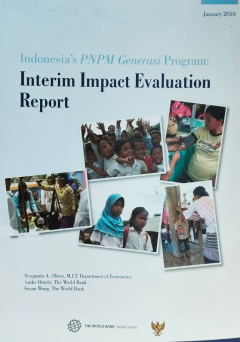
Indonesia's PNPM Generasi program : interim impact evaluation report
Laporan "Program PNPM Generasi Indonesia: Evaluasi Dampak Sementara" memberikan analisis sementara mengenai hasil dan dampak dari Program Nasional Pemberdayaan Masyarakat (PNPM) Generasi di Indonesia. PNPM Generasi adalah program pemerintah yang dirancang untuk meningkatkan kesejahteraan masyarakat, khususnya dalam sektor pendidikan dan kesehatan, dengan pendekatan berbasis komunitas.
- Edisi
- 1
- ISBN/ISSN
- -
- Deskripsi Fisik
- 152 halaman : ill. ; 28 cm.
- Judul Seri
- Textbook
- No. Panggil
- 353.5 OLK i
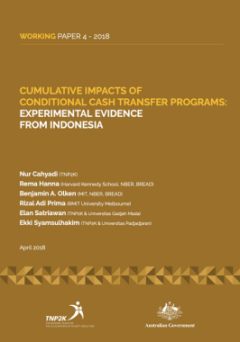
Cumulative Impacts of Conditional Cash Transfer Programs: Experimental Eviden…
- Edisi
- Working Paper 4 - 2018
- ISBN/ISSN
- -
- Deskripsi Fisik
- PDF, 66 Halaman
- Judul Seri
- Textbook dan Working Paper
- No. Panggil
- 361.1 CAH c
- Edisi
- Working Paper 4 - 2018
- ISBN/ISSN
- -
- Deskripsi Fisik
- PDF, 66 Halaman
- Judul Seri
- Textbook dan Working Paper
- No. Panggil
- 361.1 CAH c
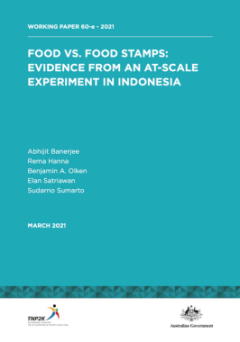
Food Vs. Food Stamps: Evidence From an At-Scale Experiment in Indonesia
Governments seeking to provide food assistance have a choice between providing in-kind food directly to beneficiaries, or providing vouchers that can be used to purchase food on the market. To understand the differences between these policies, the Government of Indonesia randomly phased in the transition from in-kind delivery of subsidized rice to approximately equivalent vouchers usable to buy…
- Edisi
- Vol 03/No. 01-03- June 2022
- ISBN/ISSN
- 977 2746857002
- Deskripsi Fisik
- PDF, 244 Halaman
- Judul Seri
- Textbook dan Working Paper
- No. Panggil
- 300.5 BAN f
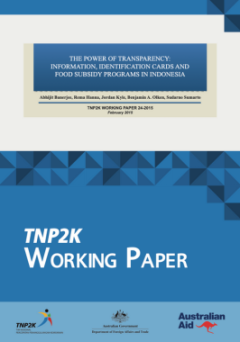
The Power of Transparency: Information, Identification Cards and Food Subsidy…
Can governments improve aid programs by providing information to beneficiaries? In our model, information can change how much aid citizens receive as they bargain with local officials who implement national programs. In a large-scale field experiment, we test whether mailing cards with program information to beneficiaries increases their subsidy from a subsidized rice program. Beneficiaries rec…
- Edisi
- TNP2K Working Paper 24-2015
- ISBN/ISSN
- -
- Deskripsi Fisik
- vii, 44 Halaman, PDF
- Judul Seri
- Working Paper
- No. Panggil
- 363.809598 BAN t
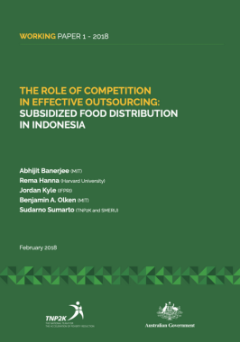
The Role of Competition in Effective Outsourcing: Subsidized Food Distributio…
Should government service delivery be outsourced to the private sector? If so, how? We conduct the first randomized field experiment on these issues, spread across 572 Indonesian localities. We show that allowing for outsourcing the last mile of a subsidized food delivery program reduced operating costs without sacrificing quality. However, prices paid by citizens were lower only where we exoge…
- Edisi
- Working Paper 1 - 2018
- ISBN/ISSN
- -
- Deskripsi Fisik
- ii, 64 Halaman, PDF
- Judul Seri
- Working Paper
- No. Panggil
- 338.1959805 BAN t

Indonesia's PNPM Generasi Program : Final Impact Evaluation Report
Indonesia has made remarkable strides in key human development indicators over the past few decades. Primary school enrollment is close to universal for both boys and girls, and the child mortality rate has declined rapidly. Nevertheless, infant mortality, child malnutrition, maternal mortality, junior secondary school enrollment, and educational learning quality have all remained problematic i…
- Edisi
- 1
- ISBN/ISSN
- -
- Deskripsi Fisik
- vii, 156 halama ; 28 cm
- Judul Seri
- Textbook
- No. Panggil
- 353.5 OLK i
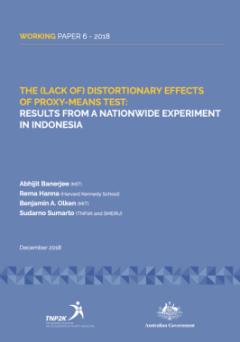
The (Lack Of) Distortionary Effects Of Proxy-Means Test:Results From A Nation…
Many developing country governments determine eligibility for anti-poverty programs using censuses of household assets. Does this distort subsequent reporting of, or actual purchases of, those assets? We ran a nationwide experiment in Indonesia where, in randomly selected provinces, the government added questions on flat-screen televisions and cell-phone SIM cards to the targeting census admini…
- Edisi
- Woking Paper 6 - 2018
- ISBN/ISSN
- -
- Deskripsi Fisik
- PDF, 36 Halaman
- Judul Seri
- Working Paper
- No. Panggil
- 330.9598 BAN.T
 Karya Umum
Karya Umum  Filsafat
Filsafat  Agama
Agama  Ilmu-ilmu Sosial
Ilmu-ilmu Sosial  Bahasa
Bahasa  Ilmu-ilmu Murni
Ilmu-ilmu Murni  Ilmu-ilmu Terapan
Ilmu-ilmu Terapan  Kesenian, Hiburan, dan Olahraga
Kesenian, Hiburan, dan Olahraga  Kesusastraan
Kesusastraan  Geografi dan Sejarah
Geografi dan Sejarah